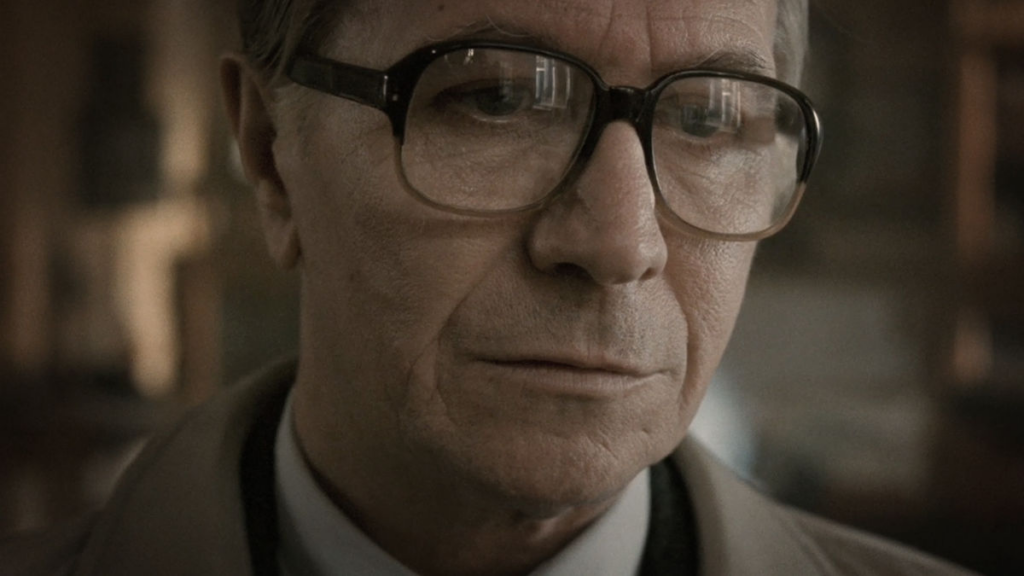Former intelligence officer turned adventure author John le Carré’s writing is in part a reaction to what he saw as Ian Fleming’s use of fantasy elements in his James Bond persona. While le Carré’s George Smiley is reserved and unassuming, Bond was brazen and aggressive. Bond’s antagonists were outrageous, and their plots were frequently absurd. In an attempt to gain an edge during the Cold War, Smiley’s adversaries sought very few sources of leverage. Smiley is the mind, and Bond is the body.
Although it is oversimplified, seeing le Carré’s most well-known book as his literary antagonist wouldn’t be the worst way to approach the 2011 movie version of it.
Ending of Tinker Tailor Soldier Spy
A Bond movie par excellence is Tinker, Tailor, Soldier, Spy. It moves slowly and offers subtle thrills. The conflicts are scuffles between remorse and treachery, trust and obligation, and the action takes place almost completely within. In the climactic scene, someone is shot, yet it is a quiet tragedy rather than a thrilling event.
The plot of Tinker, Tailor, Soldier, and Spy is treasured in the pantheon of espionage even if the film conspicuously lacks explosions, jet packs, and invisible automobiles. Even among the finest le Carré adaptations, it is regarded. Just take a look at all the actors who were in the movie. All the well-known British actors who appear in supporting parts, frequently donning hilarious period wigs, make it seem like a Harry Potter film. What sort of tale were they all eager to tell, then?

Who monitors the watchmen, wonders Tinker, Tailor, Soldier, Spy?
A government minister in the movie Tinker, Tailor, Soldier, Spy enlists retired intelligence officer George Smiley (Gary Oldman) to look into reports of a mole at the top of the British intelligence organization, known as “the Circus” in slang. After a thorough investigation, Smiley sets up a trap for senior Circus official Bill Haydon (Colin Firth). It’s implied that Haydon may have been in love with Jim Prideaux (Mark Strong), the agent he deceived, as well as Smiley’s wife Ann, with whom he had been having an affair. When Haydon is taken to jail, Prideaux murders him to get revenge for his betrayal. Smiley returns to the Circus, but now he is in charge.
The fact that Haydon was the mole, in the end, is irrelevant. Since what mattered was how Haydon was able to manage the inquiry, cutting out pages in a logbook and having Prideaux dead and caught before he knew the truth, it might have been any of the possible suspects at the top Circus. The message is not “don’t trust the person having an affair with your wife,” in other words. “Don’t trust anyone,” it says.

More significantly, it’s about how it feels to always be filled with apprehension and what sort of character it takes to be aware of all that uncertainty without becoming overwhelmed by it. Smiley is not intended to be a role model like Bond. His goal is to demonstrate what le Carré believed was necessary to complete the task.
Was Tinker, Tailor, Soldier, Spy followed by a sequel?
Installing protagonists as the leaders of intelligence agencies typically signals the start of events rather than their conclusion. Le Carré undoubtedly agreed. Tinker, Tailor, Soldier, and Spy was the fifth of a total of nine books he authored that included Smiley and other characters from the Smiley series. Even if its events occurred earlier in the series, you’ve surely at least heard of The Spy Who Came in from the Cold.
Tinker, Tailor, Soldier, Spy is the first book of a trilogy that describes Smiley’s conflict with Karla, the director of Soviet intelligence, within this body of work. Oldman started hinting at the potential of a sequel based on the third novel in the trilogy, Smiley’s People, not long after Tinker, Tailor, Soldier, Spy was published. The sequel already had a script, according to a 2016 New York Daily News story, and everything simply needed to be put in place. But it has reportedly turned out to be harder than anticipated, as may occasionally happen in convoluted spy bureaucracies.

Related – The Ending Of Stowaway – EXPLAINED!
Oldman was cited by the New York Daily News as stating, “I do miss George, but oh, no, to come back is scary because it’s got to be better.” And that could be the issue. The best espionage book ever written is acknowledged as being Tinker, Tailor, Soldier, Spy. Even if the narrative is continued in a film, there could only be one way for it to develop.

